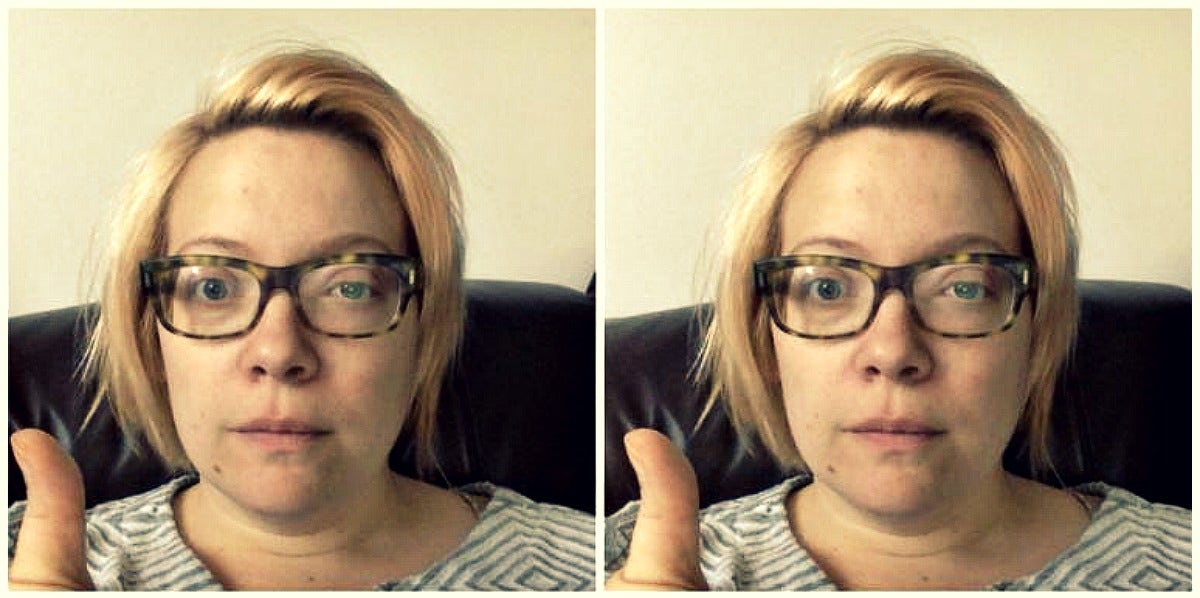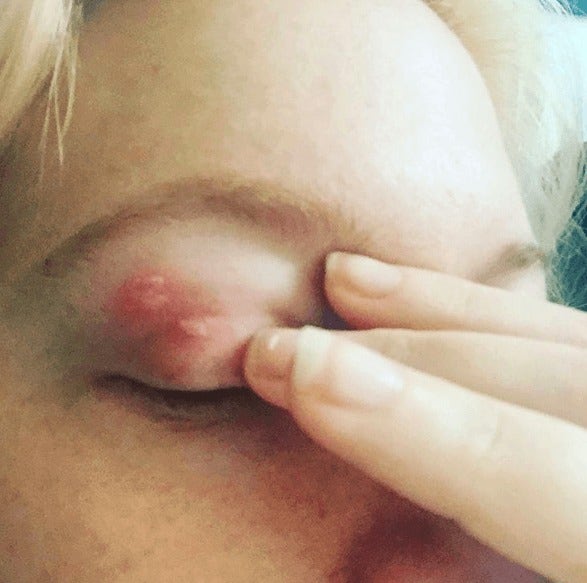I Got Shingles On My Face And It Caused Serious Depression
It's surprisingly common.
 the author
the author Two weeks before I woke up to an eyelid covered in blisters, I was pretty sure I was going through a depressive episode — which wasn't terribly surprising.
What I was not expecting was that my depression and extreme fatigue were actually early shingles symptoms.
My self-esteem was nil, too. But that's not unusual. I'm a medicated anxiety and depression sufferer, and the summer has always been a trigger for me. I have the tools to combat the malaise and insomnia that accompany my bouts of — as the French would not say — Le Grande Sad. But this felt different ... because it was different.
But I didn't trust myself enough to listen to that voice that said, "Becca, something's weird here." That something being, of course, the varicella-zoster virus unleashing itself upon my body. Turns out, the worst was yet to come.
What are shingles, and what causes shingles to develop?
First, let's get the technical stuff out of the way.
According to WebMD, if you've had chickenpox in the past, this little virus can hang out in your body for years. It's painful and most often will develop a painful, itchy, blistery rash.
WebMD explains that "shingles is caused by the varicella-zoster virus — the same virus that causes chickenpox. After you've had chickenpox, the virus lies inactive in nerve tissue near your spinal cord and brain. Years later, the virus may reactivate as shingles."
1 in 3 people will develop shingles in their lifetimes, and while it's more common to have it when you're over 60 years old, WebMD reports that more and more younger people are developing shingles. In fact, all age groups seem to have increasing rates of shingles.
You're also more likely to develop shingles if you have a depleted immune system due to conditions like AIDS/HIV or cancer, or if you're taking medications that affect your ability to fight infections.
Stress can also increase your risk of shingles.
How long do shingles last?
The good news is, that shingles don't last forever. Most cases clear up within 2 to 4 weeks.
However, some people do develop a chronic pain condition called post-herpetic neuralgia (PHN). The Mayo Clinic explains that PHN is actually the most common complication of shingles, though based on my experience and others I've talked to, it's not often discussed when patients are diagnosed.
Some people even get shingles more than once.
Other people may get early shingles symptoms, like pain or numbness, but never develop a rash. Lucky them.
Taking an anti-viral medication, which a doctor prescribes, can reduce symptoms and cut the duration of the disease, too. Catching it early and getting treatment is key to making your shingles experience less awful.
RELATED: The Scary Reality Of What Happens To Our Bodies When We're Stressed
What do shingles feel like?
To put it simply, shingles hurt and it makes you feel exhausted.
Before I'd felt any shingles symptoms in my skin, I felt an overwhelming sense of fatigue. Not knowing a virus was chilling out in my nerve tissues and preparing to wage war in my body, I put on my gym clothes and walked to the YMCA. I took my usual classes and feigned a grin. Then I went home and "napped" for four hours.
But one morning I woke up and everything was a little different. The right side of my head and neck were in total agony. Yes, classic symptoms of shingles. But I had zero idea. I was just scared.
In my experience, shingles feel like someone boiling pins and them jabbing you with them. It was all I could do not to shriek each time the nearly electrical sensation struck.
I went to the bathroom to splash water on my face and noticed that my right eye was looking a little puffy and felt ... well ... weird. It was at this point that I, totally rationally (eye roll), began to assume that I was slowly dying. Not at all an overreaction or anything!
Healthline explains that early on, shingles feel like burning or under your skin. Yep, I can confirm that. But it's not just that.
"Early symptoms of shingles may include fever and general weakness. You may also feel areas of pain, burning, or a tingling sensation. A few days later, the first signs of a rash appear." And boy did it.
Here's a photo of my shingles rash:

Photo: Author
Having self-diagnosed my imminent demise, I did what all sane people do and waited a full day before actually going to the doctor to verify my sorry state. See? I really don't trust my intuition.
Finally, I gave in and called the doctor.
By the time I was in his office, my right eye was swollen nearly shut by a patch of blisters — which is typically the most obvious shingles symptom. That's me, obviously!
What do shingles look like?
My shingles rash looked like someone had put a cigarette out on my eyelid. Frankly, I bet that would be less painful.
You would have thought by now I would've caught on ... but I never really realized that young people can get shingles. It just never crossed my mind. If I had simply done an internet search of my symptoms, it would've been obvious what I had.
According to Healthline:
"You may begin to notice pink or red blotchy patches on one side of your body. These patches cluster along nerve pathways... The rash quickly develops fluid-filled blisters similar to chickenpox. They may be accompanied by itching. New blisters continue to develop for several days. Blisters appear over a localized area and do not spread over your whole body."
Shingles also commonly have a rash that wraps around half of your waist, which people sometimes call the "shingles belt" or "shingles girdle". Lovely. I'd never heard of that, but I am also not over 70, and I assume these terms are more popular in that age bracket.
Developing shingles on your face, as I did, is common. It's also common to get them on your neck and torso — though there are lots of other possibilities. And no matter where they look truly ugly and disgusting. More importantly, those blisters hurt. It's deep down nerve pain.
Here's what my shingles looked like around my eye (photo below):

Photo: Author
So I didn't catch all those initial symptoms of shingles, but my doctor did.
"Yeah, you've got shingles," my doctor told me.
Reeling over the news that I was not going to die, I barely took in what he was telling me.
Turns out, there are other shingles symptoms people don't often discuss.
The website for the ADA explains that shingles can also cause you to feel flu-like symptoms and nausea or an upset stomach, in addition to the typical symptoms of itching, burning pain, numbness, or tingling.
In my case, shingles made me feel depressed. Although this isn't a commonly-documented symptom, there are lots of personal anecdotes of people like me who experienced depression as a symptom of shingles.
RELATED: 9 Subtle Signs Of Depression I Was Too Depressed To Notice
Strangely, it wasn't the fatigue or the depression that got to me as I started taking my medicine and applying my holistic potions. I could deal with taking naps (I'm a pretty sleepy bear anyway) and I can cope with depression.
The hardest part of shingles, for me, was looking in the mirror.
Now my self-esteem isn't stellar on my good days. I've never believed myself to be beautiful. But looking at my swollen and pus-filled eyelid my inner critic was just as loud as she had been when I was twelve and wore a matching eggplant purple velour jumpsuit to my first dance thinking I looked cool.
So in addition to being so tired that almost nothing made sense, I was now avoiding mirrors like a homely Dracula or else devolving into a puddle of pus, snot, and weeping.
When they tell you that shingles make you depressed, they don't tell you that shingles make you depressed because you are afraid to leave your house and because your face doesn't look like your face, and you're worried never will again.
On the first day my blisters seemed to be healing I took a deep breath and went for a walk. I needed it. Shingles are contagious, so doctors suggest that you stay home and away from people until your blisters "crust over" which is a really disgusting way of saying "form a scab". The fluid inside the blisters is what is contagious, and people who have no immunity to the varicella-zoster virus — like if they haven't had chickenpox or haven't been fully vaccinated against varicella — can get sick if they come into contact with it.
So, you know, wash your hands a lot, keep your blisters covered if you're around people who may be vulnerable, and don't touch your rash. Considering how much it hurts, this likely won't be that much of a challenge.
The pain was my constant companion which made me feel very melodramatic and like a Brontë character. I made it to the local garden center and nursery without incident. I needed to look at something fresh and vibrant.
Then, as I took off my sunglasses to inspect a potted plant, I heard a kid ask his mom. "What happened to her eye, mama? What's wrong with her eye?"
If I had been in possession of a velvet cape to twirl about myself as I skulked off into the darkness, believe me, I would've.
But I didn't. So instead, I pocketed my sunglasses and smiled at the kid in question.
"Do you know chickenpox? This is shingles, and it's chickenpox for grown-ups," I told him with a smile on my crusty face.
He considered this as his mom squirmed. "Do you get to stay home?" he asked.
I nodded "Yup. And watch TV."
In just a matter of seconds, I'd gone from the Beast to a source of envy.
As I write this, I'm still blistery and keeping a relatively low profile, but I'm no longer housebound. I'm also no longer avoiding my reflection. I look and assess and I don't see good or bad or pretty or ugly.
I just see a face, and if I look super close I can almost make out myself.
RELATED: Before You Say 'I Do' You Must Agree On These 25 'I Don'ts'
Rebecca Jane Stokes is the former Senior Editor of Pop Culture at Newsweek with a passion for lifestyle, geek news, and true crime.

